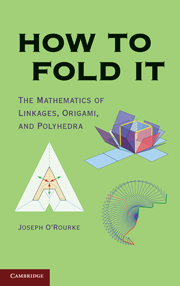3 - Protein Folding and Pop-Up Cards
Published online by Cambridge University Press: 05 June 2012
Summary
We conclude our exploration of linkages by returning to the polygonal chains that were the focus of Chapter 1, but now with angle constraints. If you struggled through Exercises 1.9 and 1.10, you know that angle constraints greatly complicate the possible motions of the chain. But in many applications, there are angle constraints, so they must be confronted. We consider two applications in this chapter, which are, surprisingly, related: protein folding and a certain pop-up card. Despite the whimsical chapter title, the real focus will be the “maxspan of 90°-chains,” the mathematical structure shared between the two applications. Several techniques and ideas from the previous chapters will resurface here, including induction and the triangle inequality.
Fixed-Angle Chains
In both the robot-arm polygonal chains we talked about in Chapter 1 and the linkages in Chapter 2, all joints are “universal,” meaning that there is complete rotational freedom at each joint. In this chapter, we explore open polygonal chains with the angle fixed at each joint, which are called fixed-angle chains. You might think that fixing the angle is the opposite extreme of allowing universal motion, and initially might seem to totally rigidify the chain into one fixed configuration. But in fact, motion is still possible in 3D: What is called revolute or dihedral motion.
Look at the 3-link chain in Figure 3.1(a), with both joint angles fixed to 90°.
- Type
- Chapter
- Information
- How to Fold ItThe Mathematics of Linkages, Origami, and Polyhedra, pp. 39 - 54Publisher: Cambridge University PressPrint publication year: 2011



